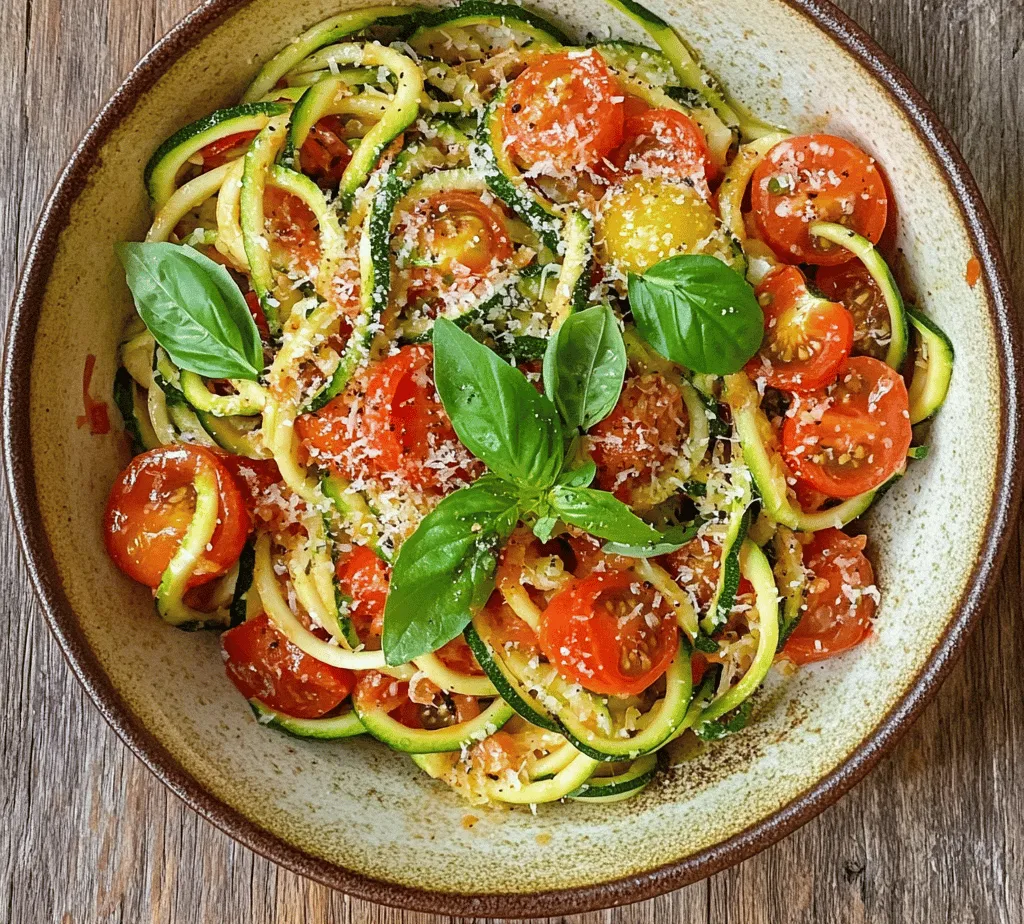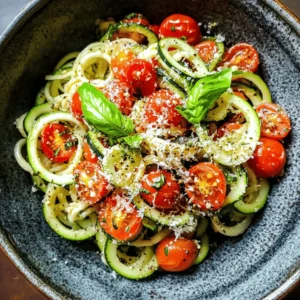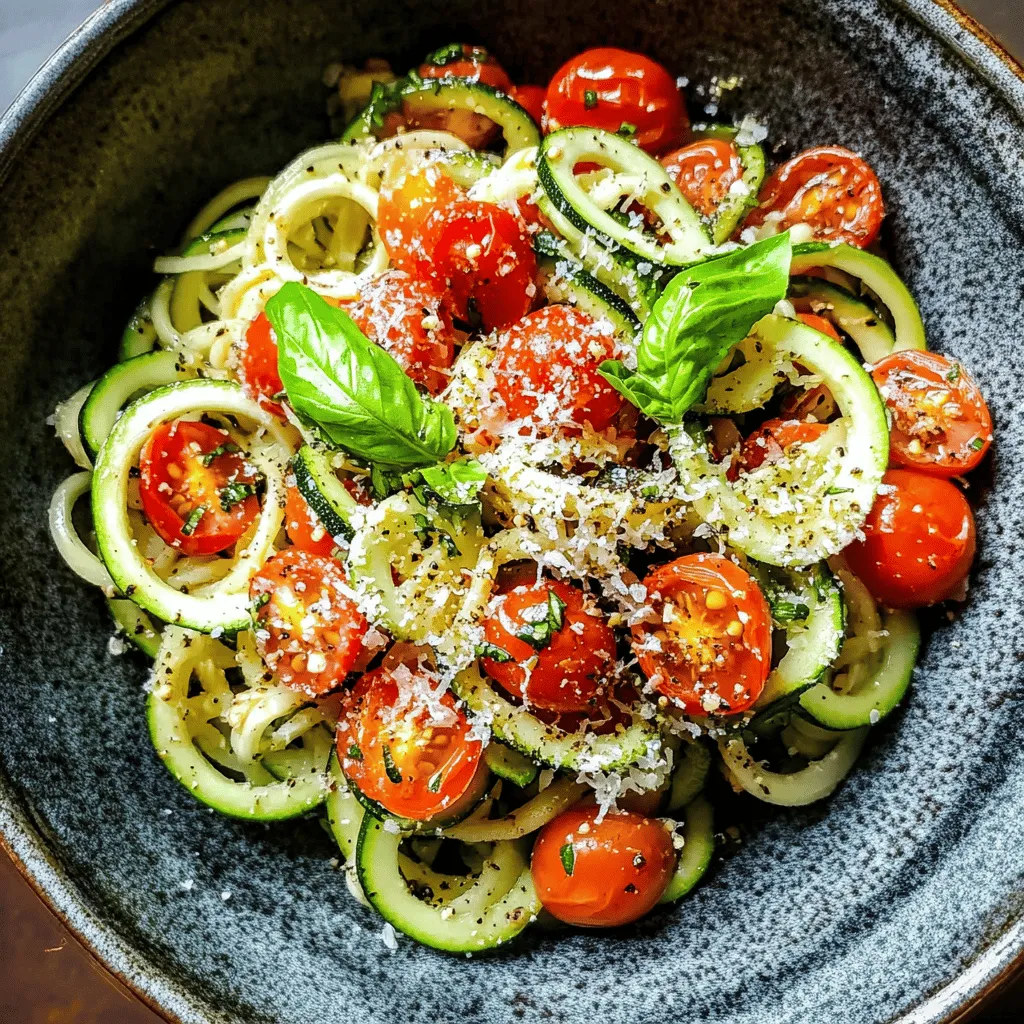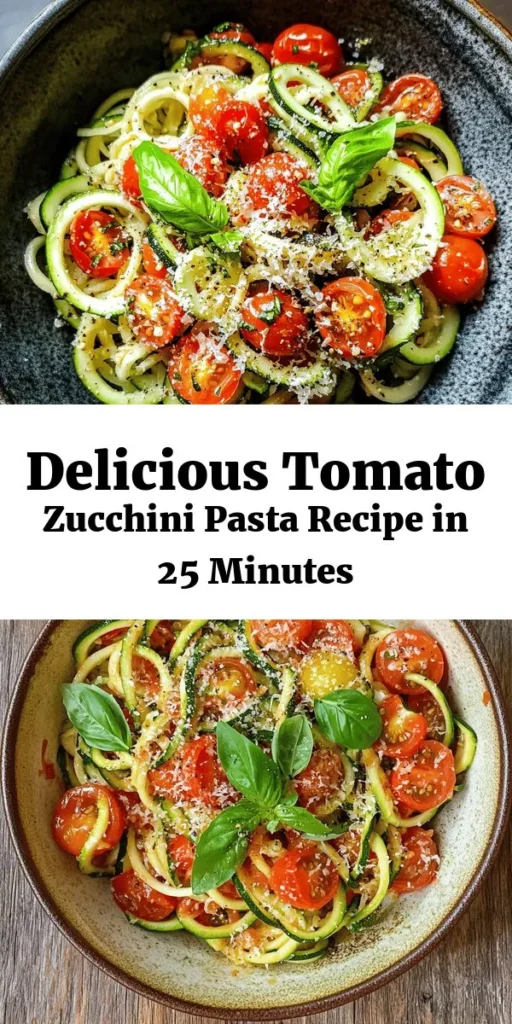Introduction
In recent years, there has been a significant shift in the culinary landscape, with an increasing number of people gravitating towards healthy, vegetable-based dishes. This movement isn’t just a trend; it reflects a growing awareness of the importance of nutritious ingredients in our diets. As more individuals seek to incorporate fresh produce into their meals, recipes that highlight vegetables as the star ingredient are becoming more popular. One such recipe that exemplifies this delicious and health-conscious approach is the Flavorful Tomato Zucchini Pasta.
This dish is not only vibrant and colorful but also a perfect blend of freshness and flavor, making it an ideal choice for anyone looking to enjoy a wholesome meal without sacrificing taste. The combination of zucchini and cherry tomatoes creates a light yet satisfying pasta that is not only visually appealing but also packed with nutrients. As we delve deeper into the ingredients and preparation of this delightful dish, you’ll discover how easy it is to create a healthy meal that bursts with flavor.
Zucchini and cherry tomatoes are two outstanding ingredients that elevate the dish in both taste and nutrition. Zucchini, often hailed as a superfood, is low in calories and high in vitamins, while cherry tomatoes offer a burst of sweetness and are loaded with antioxidants. Together, they create a harmonious balance of textures and flavors that make this pasta dish a go-to recipe for any occasion.
Understanding the Ingredients
Overview of Zucchini
Zucchini, sometimes known as courgette, is a summer squash that belongs to the gourd family. With its mild flavor and tender texture, zucchini is an incredibly versatile vegetable that can be used in a variety of dishes. It’s commonly found in Mediterranean cuisine and is celebrated for its ability to absorb flavors from other ingredients, making it a fantastic base for sauces and seasonings.
Nutritional Benefits
One of the primary reasons zucchini has gained popularity among health enthusiasts is its impressive nutritional profile. Zucchini is low in calories, with just about 20 calories per cup when sliced. It is rich in essential vitamins and minerals, including vitamin C, vitamin A, potassium, and folate. Additionally, zucchini is a great source of dietary fiber, which aids in digestion and helps maintain a feeling of fullness.
Versatility in Cooking
The versatility of zucchini cannot be overstated. It can be enjoyed raw in salads, grilled as a side dish, or baked into casseroles and breads. However, one of the most exciting ways to prepare zucchini is by transforming it into noodles, often referred to as “zoodles.” This method allows you to enjoy the texture of pasta while significantly reducing carbohydrates and calories, making it an excellent substitute for traditional wheat-based pasta.
Spotlight on Cherry Tomatoes
Cherry tomatoes are small, round, and typically sweeter than their larger counterparts. These bite-sized gems pack a punch when it comes to flavor and nutrition. They are often used in salads, sauces, and as a garnish, but their true potential shines when roasted or sautéed, releasing their natural sugars and enhancing their sweetness.
Flavor Profile and Health Benefits
The sweet and slightly tangy flavor of cherry tomatoes makes them a favorite in many dishes. They are rich in antioxidants, particularly lycopene, which has been linked to numerous health benefits, including reduced risk of heart disease and certain types of cancer. Additionally, cherry tomatoes provide vitamins A and C, potassium, and folate, contributing to overall health and wellness.
Seasonal Availability
Cherry tomatoes are typically available during the summer months, making them a seasonal favorite. When in season, they are at their peak flavor and sweetness, providing the best taste for your pasta dish. However, you can often find them in grocery stores year-round, making them a convenient option for your cooking needs.
The Role of Garlic and Olive Oil
Garlic and olive oil are essential components in Mediterranean cooking and play a critical role in enhancing the flavor of the Flavorful Tomato Zucchini Pasta.
Health Benefits of Garlic
Garlic is not only a flavorful addition to many dishes but also boasts numerous health benefits. Rich in vitamins C and B6, manganese, and selenium, garlic is known for its anti-inflammatory and antioxidant properties. It may help boost the immune system, reduce blood pressure, and improve cholesterol levels, making it a heart-healthy ingredient to include in your meals.
Importance of Quality Olive Oil
When it comes to cooking, the quality of your olive oil can significantly impact the flavor of your dish. Extra virgin olive oil, in particular, is the highest quality and retains the most nutrients. It is rich in monounsaturated fats, which are beneficial for heart health. Using high-quality olive oil in your pasta dish not only enhances the overall flavor but also adds a healthy fat component that promotes satiety.
Importance of Fresh Herbs and Spices
Fresh herbs and spices are the finishing touch that can elevate your Flavorful Tomato Zucchini Pasta from good to extraordinary.
Dried Basil vs. Fresh Basil
Basil is a classic herb used in Italian cooking, and its flavor profile is essential to this dish. While dried basil can be used in a pinch, nothing compares to the vibrant flavor of fresh basil. Fresh basil adds a bright and aromatic element to your pasta, enhancing the overall dish with its fragrant notes. When using fresh basil, be sure to add it towards the end of the cooking process to preserve its delicate flavor.
The Impact of Red Pepper Flakes on Flavor
For those who enjoy a little kick in their food, red pepper flakes are a fantastic addition. The heat from the red pepper flakes complements the sweetness of the cherry tomatoes and adds depth to the overall flavor profile of the dish. Just a pinch can transform your pasta from mild to exciting, making it an excellent choice for those who appreciate a bit of spice.
Preparation Steps Explained
Now that we’ve explored the key ingredients that will make your Flavorful Tomato Zucchini Pasta truly special, let’s dive into the preparation steps that will guide you in creating this delightful dish.
Preparing the Zucchini
The first step in making your Flavorful Tomato Zucchini Pasta is preparing the zucchini. You have a couple of options for how to cut the zucchini, depending on your preference and the tools available to you.
Methods: Spiralizing vs. Slicing
Spiralizing: If you’re looking to create zucchini noodles, a spiralizer is an excellent tool to have in your kitchen. Simply wash the zucchini, trim the ends, and place it in the spiralizer. With a few turns, you’ll have beautiful, long strands of zucchini that resemble traditional pasta. Spiralized zucchini is perfect for absorbing sauce and provides a delightful crunch.
Slicing: If you don’t have a spiralizer, don’t worry! You can simply slice the zucchini into thin rounds or half-moons. While this won’t give you the same noodle-like texture, it will still cook beautifully and complement the dish. Sliced zucchini is perfect for sautéing and adds a lovely visual appeal to the pasta.
Benefits of Choosing Zucchini Noodles Over Traditional Pasta
Choosing zucchini noodles over traditional pasta has several benefits. First and foremost, zucchini noodles are significantly lower in calories and carbohydrates, making them an ideal choice for those following low-carb or gluten-free diets. Additionally, they are packed with nutrients, which can help you feel fuller for longer. The lightness of zucchini noodles also allows the flavors of the cherry tomatoes and garlic to shine through, creating a dish that feels fresh and satisfying.
Sautéing the Tomatoes
Once your zucchini is prepared, it’s time to sauté the cherry tomatoes. This step is crucial for developing flavor and ensuring your pasta dish is bursting with deliciousness.
Techniques for Achieving the Perfect Sauté
To sauté the tomatoes, heat a generous drizzle of extra virgin olive oil in a large skillet over medium heat. Once the oil is shimmering, add minced garlic and allow it to cook for about 30 seconds, just until fragrant. Be careful not to let the garlic brown, as it can become bitter.
Next, add the halved cherry tomatoes to the skillet, along with a pinch of salt and a sprinkle of red pepper flakes. The salt will help draw out the moisture from the tomatoes, allowing them to cook down and release their natural juices. Sauté the tomatoes for about 5-7 minutes, stirring occasionally. You’ll want them to soften and burst, creating a luscious sauce that will coat your zucchini noodles beautifully.
As the tomatoes cook, their sweetness will intensify, while the garlic will infuse its flavor into the oil, creating a savory base for your pasta. This step is essential for achieving a well-balanced dish that highlights the freshness of the ingredients.
With the zucchini prepared and the tomatoes sautéed to perfection, you’re well on your way to creating a Flavorful Tomato Zucchini Pasta that will delight your taste buds and nourish your body. The combination of fresh produce, vibrant flavors, and health benefits makes this dish a must-try for anyone looking to enjoy a healthy and satisfying meal. Stay tuned for the next part where we will explore the final steps and tips for serving this delicious pasta.
—
This introduction and preparation steps outline the importance of the ingredients, their benefits, and how to prepare them for the final dish, setting the stage for a comprehensive and engaging recipe article.

The Science Behind Flavor Development During Cooking
Cooking is as much a science as it is an art. When preparing dishes like Flavorful Tomato Zucchini Pasta, understanding the chemistry behind flavor development can elevate your culinary skills. As ingredients are heated, chemical reactions occur that create new flavors, textures, and aromas, enhancing the overall taste of the dish. For instance, the Maillard reaction, which occurs when proteins and sugars in food are heated, adds depth and complexity to the flavors of sautéed vegetables like zucchini and garlic.
Additionally, the cooking process helps to break down the cell walls of vegetables, releasing their natural sugars and enhancing sweetness. This transformation is crucial for creating a balance of flavors in your pasta dish. The acidity of tomatoes complements the richness of zucchini, while garlic and herbs add aromatic layers that make each bite a delightful experience.
Combining Ingredients
One of the keys to achieving a harmonious dish is the careful combination of ingredients. When making your Tomato Zucchini Pasta, layering flavors is essential. Start by sautéing garlic in olive oil, allowing it to infuse the oil before introducing the tomatoes. This method ensures that the garlic flavor permeates the dish without burning, which can lead to bitterness.
Once the tomatoes are added, their acidity can be balanced with the sweetness of sautéed zucchini. Incorporating herbs like basil or oregano during the cooking process releases essential oils that contribute to the dish’s aroma and flavor profile. Remember to taste as you cook. Adjusting the seasoning with salt, pepper, or a splash of lemon juice can elevate the dish to new heights.
Importance of Cooking Times for Maintaining Texture
Timing is everything in cooking, especially when it comes to maintaining texture. Overcooking can lead to mushy vegetables and pasta, detracting from the overall experience of your dish. For the zucchini, a gentle sauté for about 3-4 minutes is sufficient to ensure it remains tender-crisp, providing a satisfying bite.
When it comes to the pasta, follow the package instructions for al dente cooking. This typically means cooking it for 1-2 minutes less than the recommended time to ensure it retains a slight firmness. Combining the pasta with the sautéed vegetables at the right moment prevents overcooking and helps the pasta absorb the sauce flavors, creating a cohesive dish.
How to Achieve the Right Balance of Flavors
Balancing flavors is an art that can significantly enhance your Tomato Zucchini Pasta. The combination of acidity from the tomatoes, the sweetness of zucchini, and the richness of olive oil creates a symphony of tastes. Here are some tips to achieve the perfect balance:
1. Taste Frequently: Continuously tasting your dish as you cook allows you to adjust the seasoning and acidity levels. If the dish is too acidic, consider adding a pinch of sugar to mellow the flavors.
2. Layer Flavors: Add ingredients at different stages of cooking to build complexity. For example, adding dried herbs early in the cooking process releases their oils, while fresh herbs added at the end maintain their vibrant flavor.
3. Finish with Acid: A splash of lemon juice or vinegar just before serving brightens the entire dish, enhancing flavors and providing a fresh finish.
Cooking the Pasta
How to Choose the Right Pasta
Choosing the right pasta is crucial for achieving the best texture and flavor in your dish. For Tomato Zucchini Pasta, consider using shapes that hold onto sauce well, such as penne, fusilli, or farfalle. These shapes create a delightful mouthfeel as they capture both pasta and sauce in each bite.
Whole Wheat vs. Traditional Pasta: A Nutritional Comparison
When it comes to health considerations, whole wheat pasta offers several advantages over traditional refined pasta. Whole wheat pasta is higher in fiber, which aids digestion and promotes a feeling of fullness. It also has a lower glycemic index, leading to a slower rise in blood sugar levels. However, traditional pasta has its merits too, including a lighter texture and a more neutral flavor that may allow tomato and zucchini flavors to shine through more prominently. Ultimately, the choice between whole wheat and traditional pasta can depend on personal preference and dietary needs.
Cooking Methods for Different Pasta Types
When preparing your pasta, various cooking methods can influence the final result. Here’s a quick guide:
– Boiling: The most common method, where pasta is cooked in salted boiling water. This method ensures even cooking and is essential for achieving al dente texture.
– Sautéing: For some pasta shapes, especially those that are stuffed (like ravioli), sautéing briefly after boiling can add a delightful crispness.
– Baking: For dishes like baked ziti, cooking pasta slightly less than al dente before combining it with sauce and cheese can yield a perfect final dish.
Integrating Pasta with Vegetables
Once your pasta is cooked al dente, it’s time to integrate it with the sautéed zucchini and tomatoes. This step is crucial as it allows the pasta to absorb the flavors of the sauce. Here’s how to do it effectively:
1. Reserve Pasta Water: Before draining your pasta, reserve a cup of the cooking water. This starchy water can be used to adjust the consistency of your sauce, making it cling beautifully to the pasta.
2. Combine Quickly: Add the drained pasta to the skillet with the sautéed vegetables, tossing to combine. If the mixture seems dry, add a splash of the reserved pasta water until you achieve the desired consistency.
3. Final Seasoning: Taste again and adjust with additional salt, pepper, or a drizzle of olive oil if necessary.
Tips for Ensuring Even Distribution of Flavors
To ensure that every bite of your Tomato Zucchini Pasta is bursting with flavor, consider these tips:
– Toss, Don’t Stir: Gently toss the pasta and vegetables rather than stirring aggressively. This method prevents the pasta from breaking and allows for a more even distribution of sauce and ingredients.
– Let It Rest: Allowing the pasta to sit for a few minutes after combining can help the flavors meld together, creating a more cohesive taste.
– Garnish Generously: A sprinkle of fresh herbs, grated cheese, or a dash of olive oil just before serving can enhance the dish’s flavor profile significantly.
Importance of Timing When Adding Pasta to the Skillet
Timing is crucial when adding the pasta to the skillet with your sautéed vegetables. If you add the pasta too early, it may clump together or become overcooked. Conversely, adding it too late can result in the pasta not absorbing enough flavor from the sauce. Aim to combine the pasta with the vegetables immediately after draining, ensuring a seamless transfer of flavors.
Serving Suggestions
Presentation Ideas for a Visually Appealing Dish
The presentation of your Tomato Zucchini Pasta can elevate the dining experience. Here are some ideas for serving:
1. Plating: Use a large serving bowl or individual plates to showcase your pasta. Twirl the pasta with a fork for a nest-like appearance, then artfully arrange the zucchini and tomatoes on top.
2. Color Contrast: Incorporate colorful ingredients like cherry tomatoes, baby spinach, or red pepper flakes to make the dish visually appealing.
3. Layering: Consider layering the pasta with additional sautéed vegetables or greens for added texture and color.
Garnishing with Basil and Parmesan
Garnishing your dish can significantly enhance its flavor and aesthetic appeal. Fresh basil adds a vibrant pop of color and a fragrant aroma, while freshly grated Parmesan cheese contributes a nutty depth. Here’s how to use them effectively:
– Basil: Tear fresh basil leaves just before serving to release their essential oils. Scatter them over the pasta to provide a fresh, herbaceous note.
– Parmesan: For a touch of creaminess, grate Parmesan over the top. Consider using a vegetable peeler to create thin shavings for an elegant touch.
The Role of Garnishing in Enhancing Flavor and Aesthetic
Garnishing is not just about looks; it plays a vital role in flavor enhancement. A well-chosen garnish can complement the dish’s flavors and create a multi-sensory experience. For example, a sprinkle of toasted pine nuts can add crunch, while a drizzle of balsamic reduction can introduce a sweet-tart element that balances the dish beautifully.
Optional Toppings for Dietary Preferences (Vegan Options)
For those following a vegan diet, there are plenty of options to customize your Tomato Zucchini Pasta. Here are several ideas:
– Nutritional Yeast: This is a fantastic alternative to Parmesan, providing a cheesy flavor without dairy.
– Toasted Nuts or Seeds: Pine nuts, sunflower seeds, or walnuts can add a satisfying crunch and elevate the dish nutritionally.
– Vegan Cheese: There are many plant-based cheeses available that melt beautifully and provide that creamy finish.
Nutritional Analysis of the Dish
Breakdown of Calories and Macros Per Serving
When it comes to nutrition, understanding the macronutrient profile of your Tomato Zucchini Pasta is essential. A typical serving contains approximately:
– Calories: 350-400
– Carbohydrates: 60g
– Protein: 12g
– Fat: 7g
– Fiber: 8g
These numbers can vary based on your choice of pasta and additional toppings, but this dish remains a nutritious option for a balanced meal.
Benefits of Incorporating This Dish into a Balanced Diet
Incorporating Tomato Zucchini Pasta into your diet offers numerous benefits. The dish is rich in vitamins A and C from the tomatoes and zucchini, both of which support immune health and skin vitality. Additionally, with whole wheat pasta, you gain a boost in fiber, promoting digestive health and aiding in weight management.
How It Aligns with Dietary Trends (e.g., Mediterranean Diet, Vegetarian)
This dish aligns beautifully with dietary trends such as the Mediterranean diet and vegetarian eating patterns. Rich in fresh vegetables, healthy fats from olive oil, and whole grains, it embodies the principles of these diets, which emphasize plant-based foods, lean proteins, and healthy fats. Moreover, it’s an excellent option for those looking to reduce their meat intake while still enjoying a satisfying and flavorful meal.
Conclusion
In summary, the Flavorful Tomato Zucchini Pasta is not just a dish; it’s a celebration of fresh ingredients and wholesome flavors. With its vibrant colors, delightful textures, and balanced taste, this pasta is a perfect addition to your healthy lifestyle. By understanding the science of cooking, mastering the art of flavor balance, and applying thoughtful presentation techniques, you can create a meal that’s not only nourishing but also enjoyable to prepare and eat.
Encourage yourself to embrace the joy of cooking with fresh ingredients, bringing the flavors of summer into your kitchen all year round. Whether served as a light lunch or a hearty dinner, this dish is sure to become a favorite among family and friends. Enjoy your culinary journey and the satisfaction that comes from creating delicious meals from scratch.



